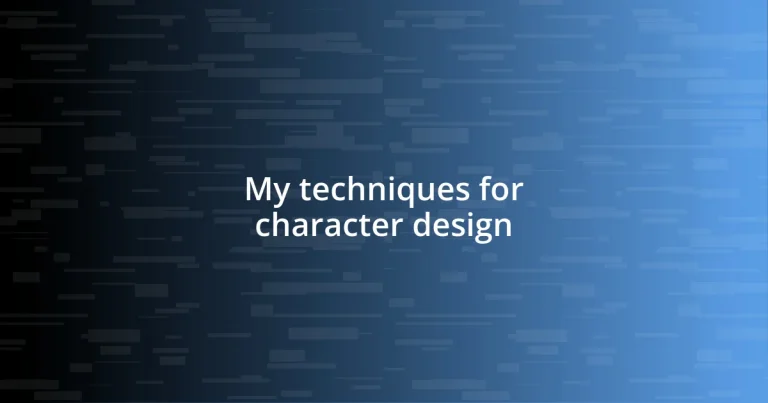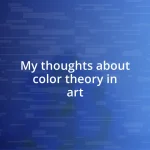Key takeaways:
- Character design involves crafting unique personalities through elements like silhouette, color, and body language, allowing for emotional storytelling.
- Researching a character’s background and traits is vital for depth and authenticity, influencing their motivations and behaviors.
- Details in outfits and accessories can reveal a character’s identity and history, making them relatable and memorable to audiences.
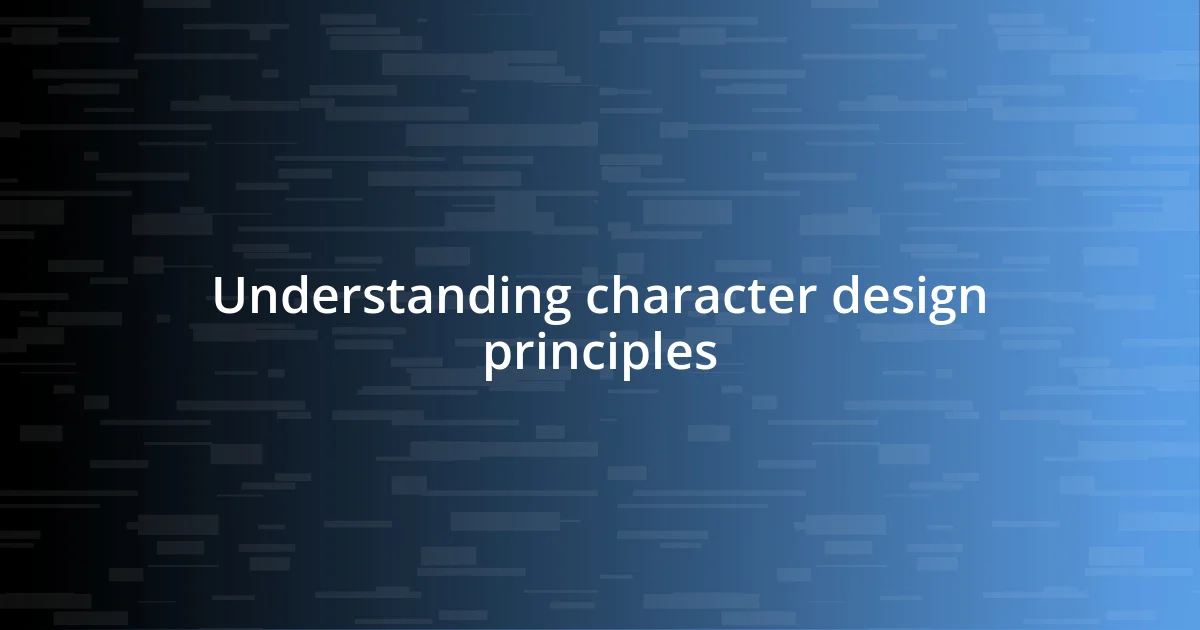
Understanding character design principles
Understanding character design principles involves more than just creating a visually appealing character; it’s about breathing life into a unique personality. For instance, when I first began designing characters, I grappled with how to depict emotions through facial expressions and body language. It’s fascinating how a slight tilt of the head or the curve of a smile can convey a character’s entire backstory, isn’t it?
One essential principle I learned is the importance of silhouette. A well-designed character should be easily recognizable even in shadow. I remember a project where I spent hours perfecting the silhouette of a hero I was creating, only to realize that a simple tweak made all the difference. Instantly, the character felt more dynamic and engaging, which taught me the power of form and shape in character design.
Additionally, color can evoke emotions and influence perceptions. For my own characters, assigning a specific color palette often comes down to what I want the audience to feel. I once designed a character with warm oranges and reds to exude energy and passion, while a cool blue palette for another signified calm and mystery. Have you ever noticed how certain colors stick with you or influence your perspective on a character? It’s an undeniable aspect of character design that deserves thoughtful consideration.
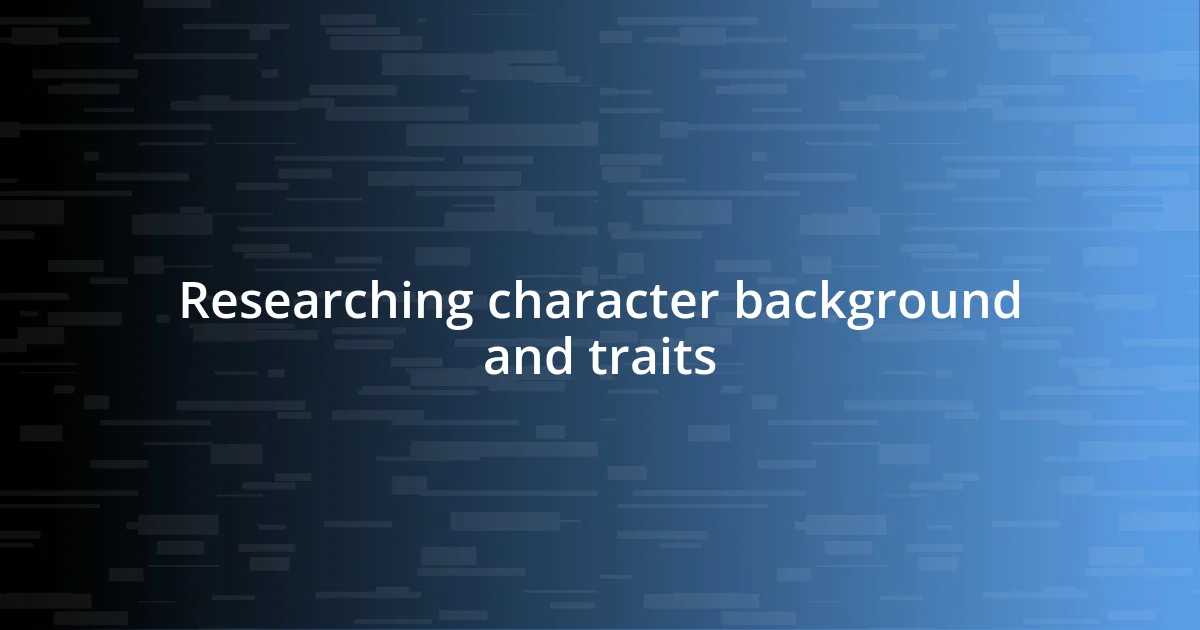
Researching character background and traits
Researching a character’s background and traits is essential for creating depth and authenticity. When I delve into a character’s history, I often visualize their life experiences, which informs their motivations and behavior. For example, I once developed a character who grew up in a bustling city. This upbringing shaped not only their attitude towards life but also influenced their relationships. It’s incredible how such details can resonate with audiences, making characters feel real.
I always consider how a character’s background informs their traits. Do they have trust issues because of a betrayal in their past? Or maybe they’re overly confident due to countless victories? I recall working on a character with a traumatic childhood. This aspect enhanced her resilience but also made her wary of vulnerability. By exploring these dimensions, I ensure my characters evolve in a way that reflects their experiences, creating a rich tapestry of traits.
An efficient approach I use is creating a simple comparison table. This table helps me outline key traits and backgrounds swiftly, making the information visually digestible. Being organized in this way can clarify the points I want to convey. Below is a format I commonly follow:
| Character Trait | Background Influence |
|---|---|
| Resilient | Overcame childhood trauma |
| Trust Issues | Betrayed by a close friend |
| Confident | Numerous successes in competitions |
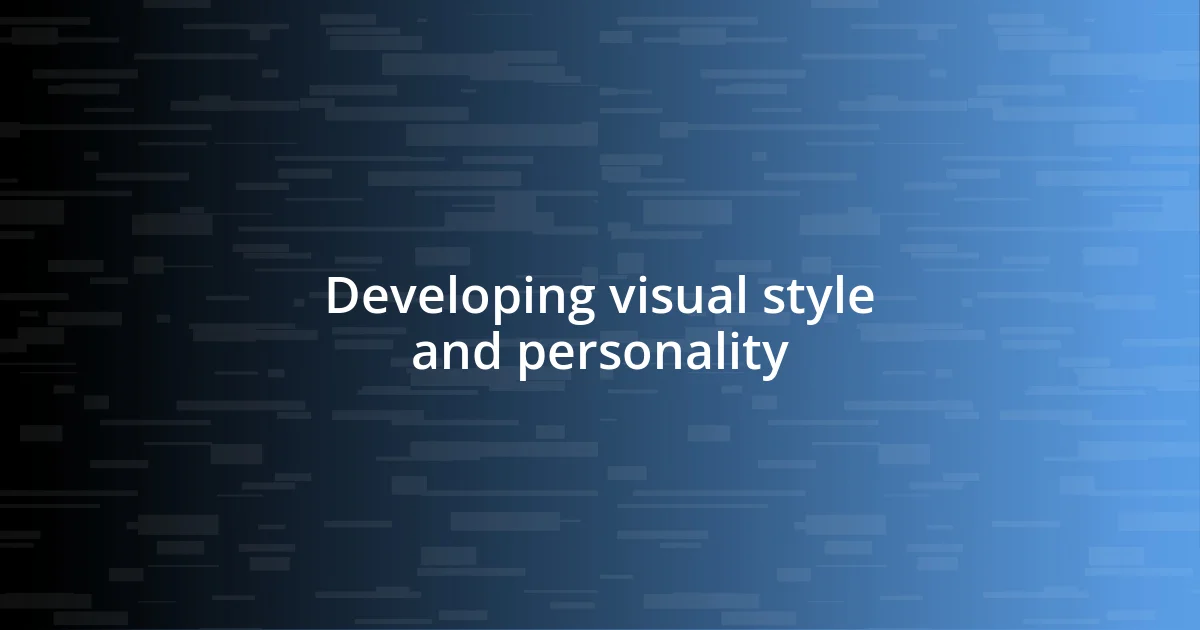
Developing visual style and personality
I often find that developing a character’s visual style goes hand in hand with shaping their personality. When I design outfits or accessories, I consider how those choices reveal something deeper about who the character is. For example, I created a quirky character who always wore mismatched patterns. This wasn’t just a random decision; it reflected their free-spirit and disregard for societal norms. Every visual detail works as a storytelling device, grabbing the viewer’s attention while hinting at the character’s inner world.
To enhance the connection between visual style and personality, I keep these points in mind:
- Costume Choices: Reflect internal beliefs or social status. A sleek, tailored outfit might show a character’s ambition, while a more casual look indicates a laid-back attitude.
- Color Psychology: Different colors can signify different moods. For instance, a character dressed in greens might evoke feelings of harmony or jealousy, depending on the context.
- Accessories and Details: Small elements like jewelry or gadgets can reveal interests or personal history, such as a vintage watch hinting at nostalgia.
- Posture and Expression: Body language conveys as much as clothing. A character who stands tall and open invites confidence, while a hunched posture might suggest insecurity.
Stitching together these visual elements with a character’s personality allows for a more seamless narrative experience. Recently, I designed a character with a collection of charms representing important moments in their life. As I worked on each charm, I felt a stronger affinity for the character, which made me realize how intertwined visuals and personality truly are in character design.
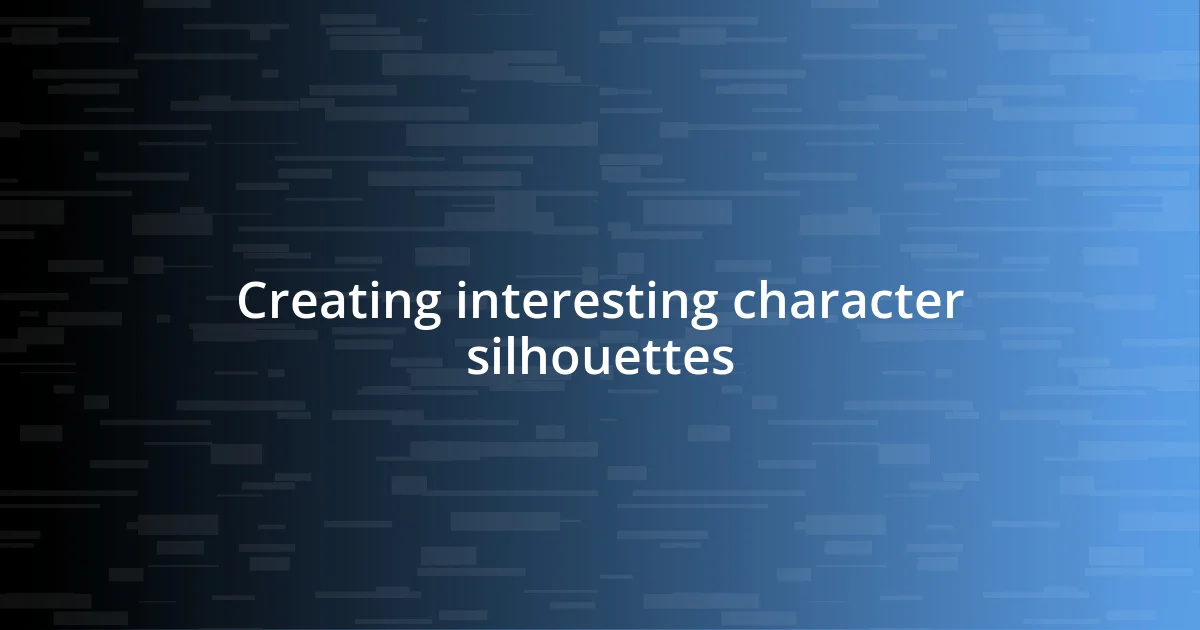
Creating interesting character silhouettes
Creating interesting character silhouettes is a fascinating challenge. I remember sketching an adventurous rogue, and the silhouette was key to capturing her essence. She had an oversized cloak that billowed out behind her, which not only emphasized her agility but also hinted at the secrets she carried. Isn’t it amazing how a simple shape can convey so much about a character’s personality and story?
When I focus on silhouettes, I often play with exaggeration. For example, I once designed a character whose large, spiky hair made her appear dynamic and fierce. The added height from her hair contrasted beautifully with her petite frame, enhancing her intimidating presence. It’s intriguing how shapes can define dominance or vulnerability—don’t you think? Consider how a stout silhouette might evoke a sense of strength while a slender one could suggest nimbleness.
Experimentation is also vital in silhouette creation. I often engage in quick thumbnail sketches to explore different forms. One time, I was crafting a noble character and initially stuck to traditional shapes. Then, I decided to add an elaborate helmet that overshadowed her head, instantly transforming her into a more formidable figure. It taught me that sometimes stepping out of conventional boundaries leads to the most compelling and memorable designs.
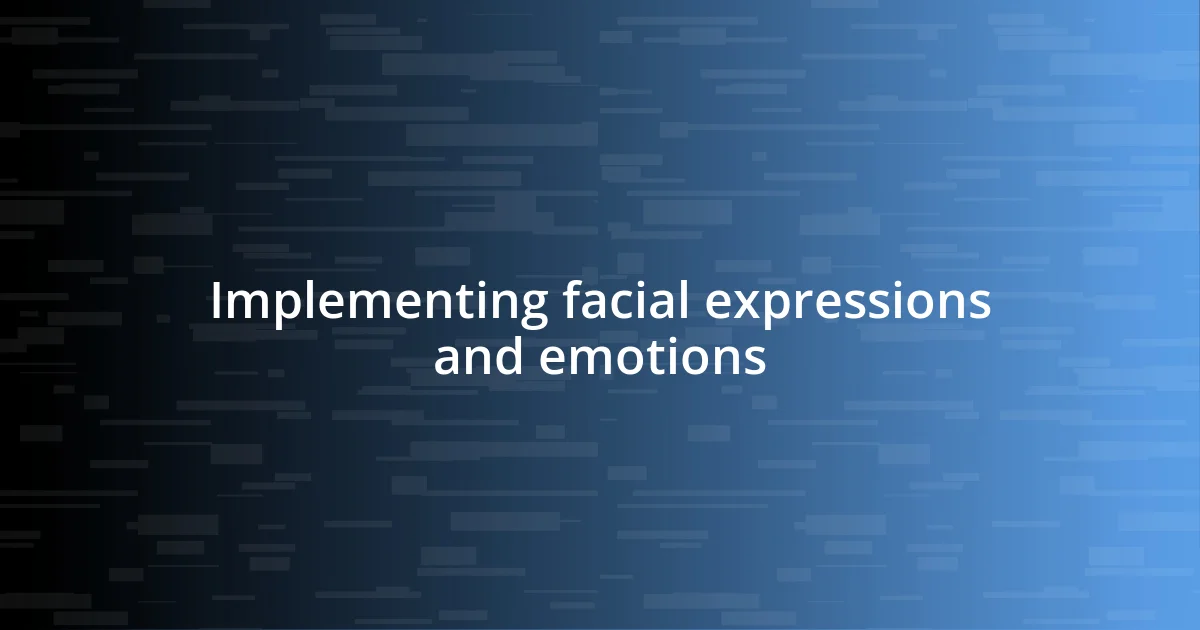
Implementing facial expressions and emotions
When implementing facial expressions and emotions, I have learned that subtlety is key. I recall working on a character whose face would shift from a cheerful grin to a contemplative frown in mere seconds, revealing the complexity of her inner thoughts. It reminded me that the smallest change in a character’s brow or lip curvature can tell a story of its own. Have you ever noticed how just a slight arch of an eyebrow can suggest suspicion or surprise? It’s fascinating how our own expressions can inspire the characters we create.
One technique I find particularly effective is referencing real-life emotions. For instance, the last time I experienced genuine joy—a spontaneous moment spent with friends—I paid attention to what my face did during those laughs. I noticed how my eyes lit up and created crinkles at the corners, while my mouth widened in an almost uncontrollable smile. Moments like this guide me in capturing that sparkle in a character’s eyes, making them feel relatable and alive. How often do we connect with characters simply through that flash of authenticity on their face?
I often sketch multiple expressions for the same character to evoke their emotional range. A key memory stands out when I developed an anxious character, whose face evolved from a tight-lipped smile to an almost trembling look of uncertainty. This practice not only expands my character’s emotional depth but also helps me tap into my intuition about how they would react in various scenarios. I think about how engaging it is to see a character’s journey through their expressions; isn’t that what truly connects us as viewers and creators?
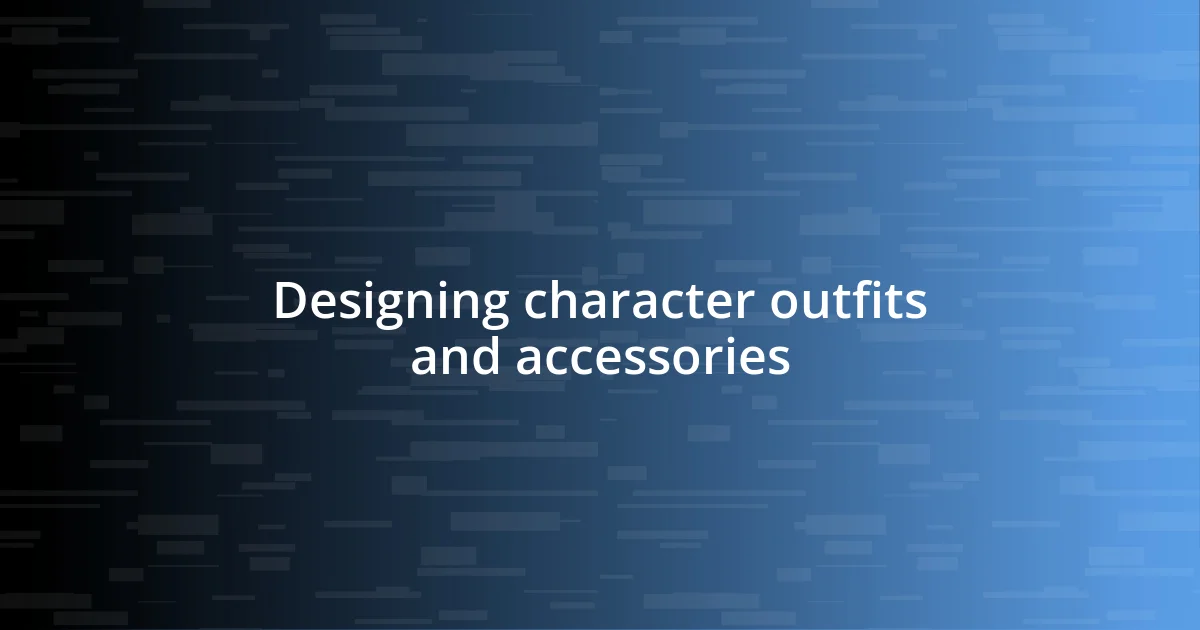
Designing character outfits and accessories
Designing outfits and accessories is a delightful exploration of a character’s identity. I fondly recall designing a battle-hardened warrior, where every piece of armor reflected her storied past. The weathered textures and battle scars on her leather straps told stories without a single word. Isn’t it exhilarating how the right outfit can be an unspoken narrative?
I love layering clothing for added depth. Once, I created a whimsical mage whose vibrant ensemble mixed patterns and colors, each layer revealing a different aspect of her personality. The flowing robes, adorned with celestial motifs, immediately gave her an air of mystery and magic. It’s intriguing how each detail—from an oversized belt buckle to a dangling charm—can transform an ordinary outfit into a spellbinding visual statement, wouldn’t you agree?
Accessories also hold tremendous potential to deepen character expression. I remember sketching a quirky inventor whose goggles and tool-filled apron became extensions of her adventurous spirit. They weren’t just functional; they embodied her passion for creation. Reflecting on this, I wonder, do we sometimes overlook the power of small details? In character design, those little touches often spark a connection, making them resonate with audiences long after they’ve seen the character.












